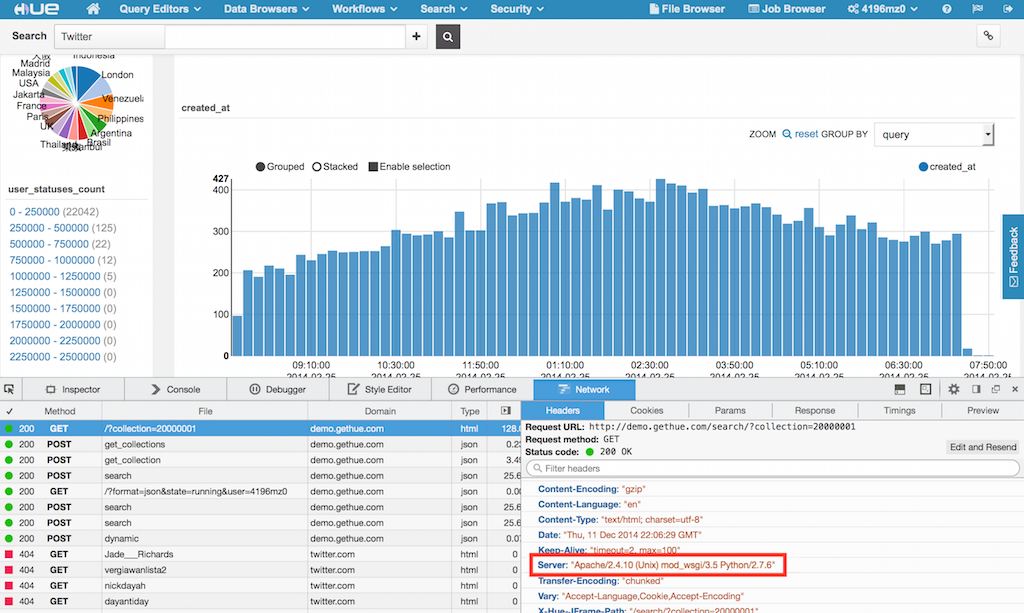---
title: How to run Hue with the Apache Server
author: admin
type: post
date: 2014-12-11T23:21:39+00:00
url: /how-to-run-hue-with-the-apache-server/
sf_thumbnail_type:
- none
sf_thumbnail_link_type:
- link_to_post
sf_detail_type:
- none
sf_page_title:
- 1
sf_page_title_style:
- standard
sf_no_breadcrumbs:
- 1
sf_page_title_bg:
- none
sf_page_title_text_style:
- light
sf_background_image_size:
- cover
sf_social_sharing:
- 1
sf_sidebar_config:
- left-sidebar
sf_left_sidebar:
- Sidebar-2
sf_right_sidebar:
- Sidebar-1
sf_caption_position:
- caption-right
sf_remove_promo_bar:
- 1
slide_template:
- default
sf_thumbnail_image:
- 1892
categories:
---
Hue ships out of the box with the HTTP server [CherryPy][1], but some users have expressed interest having [Apache HTTP 2][2] serve Hue with [mod_wsgi][3]. Their motivation is that they are more familiar with Apache or have already several Apache instances deployed.
It turns out it’s pretty simple to do. It only requires a small script, a Hue configuration option, and a configuration block inside Apache. This post describes how to have Apache serve the static content and run the Python code of Hue.
This script (which was just added in [`desktop/core/desktop/wsgi.py`][4]) enables any Web server that speaks WSGI to launch Hue and route requests to it:
import os
os.environ.setdefault("DJANGO_SETTINGS_MODULE", "desktop.settings")
\# This application object is used by the development server
\# as well as any WSGI server configured to use this file.
from django.core.wsgi import get_wsgi_application
application = get_wsgi_application()
The next step disables booting Hue from the `runcpserver` command. In Cloudera Manager, go to **Hue** > **Configuration** > **Service-Wide** > **Advanced**, and add the following to the hue safety valve:

If you are [running Hue outside of Cloudera Manager][5], modify `desktop/conf/hue.ini` with:
[desktop]
...
enable_server=no
The final step is to configure Apache to launch Hue by adding the following to the `apache.conf`:
WSGIScriptAlias / $HUE_PATH/desktop/core/src/desktop/wsgi.py
WSGIPythonPath $HUE_PATH/desktop/core/src/desktop:$HUE_PATH/build/env/lib/python2.7/site-packages
WSGIDaemonProcess $HOSTNAME home=$HUE_PATH python-path=$HUE_PATH/desktop/core/src/desktop:$HUE_PATH/build/env/lib/python2.7/site-packages threads=30
WSGIProcessGroup $HOSTNAME
Order Deny,Allow
\# If apache 2.4
Require all granted
\# otherwise
\# Allow from all
\# Some systems, like Redhat, lock down /var/run, so you may need to change where to store the socket with:
\# WSGISocketPrefix run/wsgi
Where `$HOSTNAME` should be the hostname of the machine running Hue, and `$HUE_PATH` is where Hue is installed. If you’re using Cloudera Manager, by default it should be either `/usr/lib/hue` for a package install, or `/opt/cloudera/parcels/CDH/lib/hue` for a parcel install.
[ ][6]
Have any questions? Feel free to contact us on [hue-user][7] or [@gethue][8]!
[1]: http://www.cherrypy.org/ "CherryPy"
[2]: http://httpd.apache.org/ "Apache HTTP 2"
[3]: https://code.google.com/p/modwsgi/
[4]: https://github.com/cloudera/hue/blob/master/desktop/core/src/desktop/wsgi.py
[5]: https://gethue.com/how-to-configure-hue-in-your-hadoop-cluster/
[6]: https://cdn.gethue.com/uploads/2014/12/Untitled2.png
[7]: http://groups.google.com/a/cloudera.org/group/hue-user
[8]: https://twitter.com/gethue
][6]
Have any questions? Feel free to contact us on [hue-user][7] or [@gethue][8]!
[1]: http://www.cherrypy.org/ "CherryPy"
[2]: http://httpd.apache.org/ "Apache HTTP 2"
[3]: https://code.google.com/p/modwsgi/
[4]: https://github.com/cloudera/hue/blob/master/desktop/core/src/desktop/wsgi.py
[5]: https://gethue.com/how-to-configure-hue-in-your-hadoop-cluster/
[6]: https://cdn.gethue.com/uploads/2014/12/Untitled2.png
[7]: http://groups.google.com/a/cloudera.org/group/hue-user
[8]: https://twitter.com/gethue

 ][6]
Have any questions? Feel free to contact us on [hue-user][7] or [@gethue][8]!
[1]: http://www.cherrypy.org/ "CherryPy"
[2]: http://httpd.apache.org/ "Apache HTTP 2"
[3]: https://code.google.com/p/modwsgi/
[4]: https://github.com/cloudera/hue/blob/master/desktop/core/src/desktop/wsgi.py
[5]: https://gethue.com/how-to-configure-hue-in-your-hadoop-cluster/
[6]: https://cdn.gethue.com/uploads/2014/12/Untitled2.png
[7]: http://groups.google.com/a/cloudera.org/group/hue-user
[8]: https://twitter.com/gethue
][6]
Have any questions? Feel free to contact us on [hue-user][7] or [@gethue][8]!
[1]: http://www.cherrypy.org/ "CherryPy"
[2]: http://httpd.apache.org/ "Apache HTTP 2"
[3]: https://code.google.com/p/modwsgi/
[4]: https://github.com/cloudera/hue/blob/master/desktop/core/src/desktop/wsgi.py
[5]: https://gethue.com/how-to-configure-hue-in-your-hadoop-cluster/
[6]: https://cdn.gethue.com/uploads/2014/12/Untitled2.png
[7]: http://groups.google.com/a/cloudera.org/group/hue-user
[8]: https://twitter.com/gethue